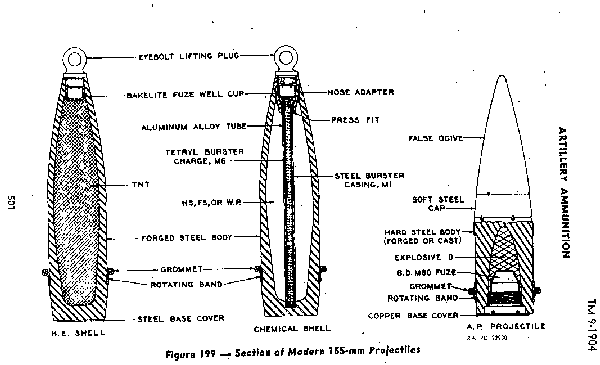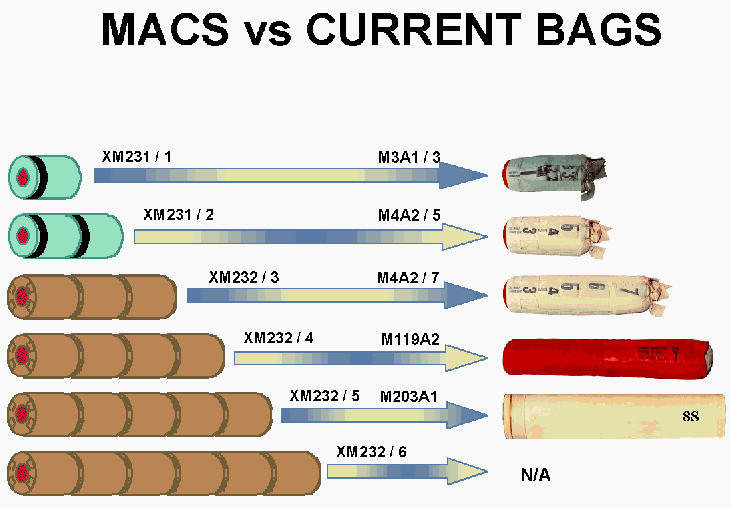The 155mm diameter projectiles offer a wide range of options for battlefield usage.
- M104 - Delivers H or HD blister gas [not in active service, slated for destruction].
- M107 - The Army's standard high explosive (HE) projectile used principally for fragmentation and blast effects.
- M110A1/A2 - Delivers H or HD blister gas [not in active service, slated for destruction].
- M116A1/B1 - Creates white chemical smoke for screening, spotting and signaling.
- M121/A1 - GB or VX nerve gas [not in active service, slated for destruction]
- M122 - GB nerve gas [not in active service, slated for destruction]
- M549A1 RAP - Comprised of two components, a high explosive warhead and a rocket motor; the rocket motor ignites following discharge from the cannon and extends the effective range of the cannon.
- M687 - Binary GB nerve gas [not in active service]
- M795 - HE projectile intended to replace the stockpiled M107 and designed to be fired using top zone propelling.
- M825 WP white phosphorus smoke
-
DPICM
- M231 MACS
- M232 MACS
- M449A1 - Delivers anti-personnel submunitions to defeat enemy personnel in open or uncovered areas.
- M483A1 FASCAM - Used to deliver a cargo of 88 M46 grenades for defeating armor and personnel targets.
- M485A1/A2 - Dispenses illumination cargo to provide unaided nighttime vision.
- M692 ADAM - Delivers anti-personnel mines.
- M718A1 RAAM - Delivers anti-tank mines to deny/delay access to a particular area.
- M731 ADAM - Delivers anti-personnel mines.
- M741A1 RAAM - Delivers anti-tank mines to deny/delay access to a particular area.
- M825A1 - Most improved version of white phosphorus smoke for obscuring vision to screen maneuvering forces.
- M864 DPICM - Similar to the M483A1 with the addition of a base burner assembly to decrease drag and increase range.
- XM867 - Developmental projectile which employs electronic radio jamming devices.
- M712 Copperhead
- XM898 SADARM - Developmental projectile with a cargo of two submunitions capable of defeating heavily armored vehicles. Each submunition contains sensors for target detection, a means for stabilizing and controlling the rate of descent, and a warhead capable of defeating armor.
- XM982 - Similiar to the M483A1 with the addition of a rocket motor to further increase the effective range, and with options to increase delivery accuracy.

Separate loading ammunition is used in 155mm howitzers. Separate loading ammunition has four separate components: primer, propellant, projectile, and fuze. The four components are issued separately. Upon preparation for firing, the projectile and propellant are loaded into the howitzer in two separate operations. Separate loading ammunition propellants are issued as a separate unit of issue in sealed canisters to protect the propellant. The amount of propellant to be fired with artillery ammunition is varied by the number of propellant increments. The charge selected is based on the range to the target and the tactical situation.
- Green Bag, M3A1, propellant is designed for firing charges 1 through 5. The propellant is fastened together with four cloth straps sewn to the base and hand tied on top of increment 5. The igniter pad (3.5 oz. CBI) is located on the base increment. The entire M3A1 propellant contains approximately 5.5 pounds of single perforated neutral burning powder. There are flash reducers containing potassium sulfate or potassium nitrate sewn forward of charges 1 (2 oz. pad), 4 and 5 (1 oz. pad each). Explain that each increment varies in size and also explain the purpose and function of flash reducers. The flash reducers limit breech flare back, muzzle flash, and blast over-pressure.
- White Bag, M4A2 propellant is designed for charges 3 through 7. Their basic configuration is the same as GB propellant. The M4A2 contains approximately 13 lbs. of multi-perforated, (Progressive burn) propellant. A flash reducer pad containing one ounce of potassium nitrate or potassium sulfate is sewn to the base increment.
- Charge 8WB, M119 - This single increment, multiperforated, white bag charge with a perforated igniter core tube extending through the center of the propellant with a flash reducer sewn to the forward end. It can only be used in the long tube 155mm howitzers (M19 series and the M198). STORE HORIZONTALLY due to the central, perforated igniter core tube. Cannot fire rocket-assisted projectiles using M119 due to the design of the flash reducer.
- Charge 8WB, M119A1, is exactly the same as the M119 except for the donut shaped flash reducer sewn to the forward end. This design of the flash reducer precludes ignition of the rocket motor for RAP.
- Charge 7RB, M119A2, is a single increment 7 red bag charge for firing in 155mm howitzers that have the M185 and M199 cannon tubes. The forward end of the charge has a 3-ounce lead foil liner and four pockets sewn longitudinally to the circumference. Each of the four pockets contains 4 oz of potassium sulfate to act as a flash reducer. Charge 7RB can be used interchangeably with charge 8WB with a minor difference in muzzle velocity. The M119A2 was created to correspond with existing NATO firing tables.
- M203 propellant is a zone 8S charge designed to provide extended range for the M198, M19A5/A6 howitzers. The M203 propellant charge is a single increment, red bag charge with a central igniter core extending through its entire length and a donut-shaped flash reducer at the forward end of the charge. The M203 is used only with the M549A1 (TNT loaded) RAP, the M825 FELT WEDGE, and the M864 base bleed projectiles.
- M203A1 Propellant Also a single increment base ignited charge. The outer casing is a solid combustible material. There is still an igniter pad at the base of the propellant, and it contains .7 ounces of black powder and 1- ounce of CBI. The propellant is not made up of granules; it consists of 28-pounds of slotted, stick propellant. The M203A1 charge is fired only with the M549A1 (TNT loaded), RAP, M825 felt wedge, and M864 projectiles in the M198 and M109A5/6 howitzers. The reasons for design of the M203A1 propelling charge are; 1) cooler burning, less flash, blast, and tube wear. 2) Casing form is more durable causing for less igniter core damage. 3) For automatic loading systems, it allows fewer mechanical problems.
The Modular Artillery Charge System, a replacement system for 155mm propelling charges, offers simplified logistics compared to traditional bag propellant systems.



